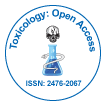Protein Toxicity
Received: 12-Oct-2021 / Manuscript No. tyoa-21-44087 / Editor assigned: 15-Oct-2021 / PreQC No. tyoa-21-44087 / Reviewed: 13-Jan-2022 / QC No. tyoa-21-44087 / Revised: 17-Jan-2022 / Manuscript No. tyoa-21-44087 / Accepted Date: 13-Jan-2022 / Published Date: 24-Jan-2022 DOI: 10.4172/ 2476-2067.1000172
Discription
Protein toxicity is the effect of the buildup of protein metabolic waste compounds due to poor kidney function. It can occur in people with pre-existing chronic kidney disease, or those who have lost kidney function due to age [1].
Occurrence: Protein toxicity occurs when an individual with impaired kidney function put away a protein-rich diet, specifically, proteins from animal sources that are rapidly immersed into the blood stream and are rapidly metabolized, causing the release of a high concentration of toxic nitrogenous waste material.
Effects of a high protein diet: A high-protein diet is a health concern for those suffering from kidney disease. The main concern is that a high protein intake may promote further renal damage that can lead to protein toxicity. The physiological changes induced by an increased protein intake, such as an increased glomerular pressure and hyper filtration, place further strain on already damaged kidneys [2]. This strain can lead to proteins being inadequately metabolized and subsequently causing toxicity. A high-protein diet can lead to impediments for those with renal disease and has been linked to further progression of the disease. The well-known Nurse’s Health Study found a correlation among the loss of kidney function and an improved dietary intake of animal protein by patients who had already been diagnosed with renal disease. This association recommends that a total protein intake that exceeds the suggestions may accelerate renal disease and lead to risk of protein toxicity within a diseased individual. For this reason, dietary protein restriction is a common treatment for patients with renal disease in which proteinuria is present [3]. Protein regulated patients have been shown to have slower rates of progression of their renal diseases.
Several studies, however, have found no confirmation of protein toxicity due to high protein intakes on kidney function in healthy people. Diets that regularly exceed the recommendations for protein intake have been found to lead to an improved glomerular filtration rate in the kidneys and also have an effect on the hormone systems in the body [4]. It is well established that these physiological effects are harmful to individuals with renal disease, but research has not found these responses to be damaging to those who are healthy and demonstrate adequate renal activity. In people with healthy kidney function, the kidneys work continuously to excrete the by-products of protein metabolism which prevents protein toxicity from occurring. In response to an increased consumption of dietary protein, the kidneys maintain homeostasis within the body by operating at an increased capacity, producing a higher amount of urea and subsequently excreting it from the body. Although some have proposed that this increase in waste production and excretion will cause increased strain on the kidneys, other study has not supported this. Currently, evidence suggests that changes in renal function that occur in response to an increased dietary protein intake are part of the normal adaptive system employed by the body to sustain homeostasis. In a healthy individual with well-functioning kidneys, there is no need for concern that an increased dietary protein intake will lead to protein toxicity and decreased renal function.
Symptoms: Unexplained vomiting and a loss of appetite are indicators of protein toxicity. If those two symptoms are accompanied by an ammonia quality on the breath, the onset of kidney failure is a likely culprit. People with kidney disease who are not on dialysis are advised to avoid consumption of protein if possible, as intense too much accelerates the condition and can lead to death. Most of the problems stem from the accumulation of unfiltered toxins and wastes from protein metabolism [5].
Diagnosis: A confirmation of kidney failure is often obtained by performing a blood test which measures the concentration of creatinine and urea (blood urea nitrogen).
References
- Anuradha S, Arora S, Mehrotra S, Arora A, Kar P (2004) Acute renal failure following para-phenylenediamine (PPD) poisoning: A case report and review. Ren Fail 329-332. s
- Almeida P,Borrego L, Melian E, Diaz O (2012) Quantification of p-phenylenediamine and 2-hydroxy-1, 4-naphthoquinone in henna tattoos. Contact Dermatitis 33-37.
- Abdel-Moneim A (2017) Acute toxicity by hair dye in upper Egypt. Int J Forensic Sci Pathol 305-311.
- Beshir L,Kaballo B,Young D (2017) Attempted suicide by ingestion of hair dye containing p-phenylenediamine: A case report.Ann Clin Biochem 507-510 .
- Shafiq M, Faran M, Iqbal A, Baqai HZ (2015) Kala Pathar poisoning. J Rawal Med Coll 98-99.
Indexed at, Google Scholar, Crossref
Indexed at, Google Scholar, Crossref
Indexed at, Google Scholar, Crossref
Citation: lyion S (2022) Protein Toxicity. Toxicol Open Access 8: 1000e117. DOI: 10.4172/ 2476-2067.1000172
Copyright: © 2022 lyion S. This is an open-access article distributed under the terms of the Creative Commons Attribution License, which permits unrestricted use, distribution, and reproduction in any medium, provided the original author and source are credited.
Share This Article
Open Access Journals
Article Tools
Article Usage
- Total views: 1928
- [From(publication date): 0-2022 - Apr 03, 2025]
- Breakdown by view type
- HTML page views: 1427
- PDF downloads: 501
